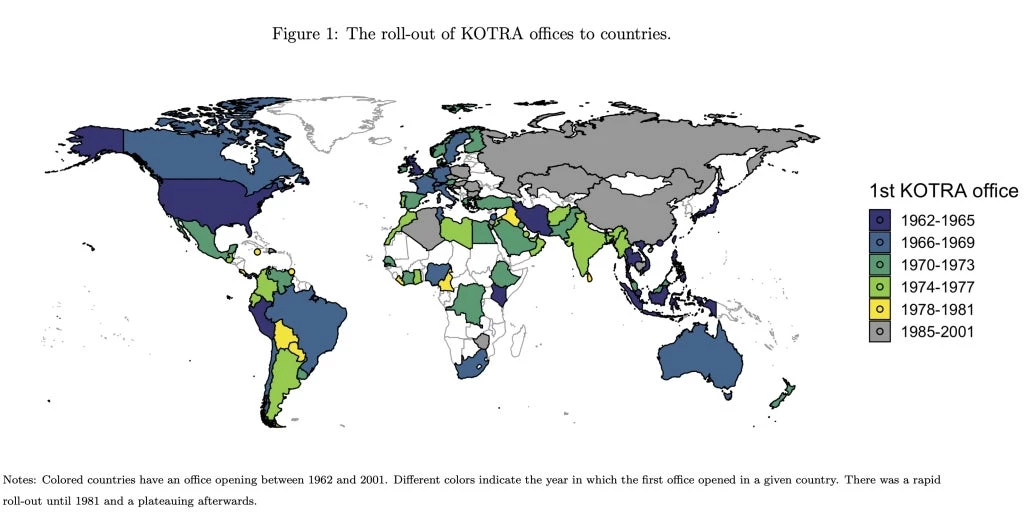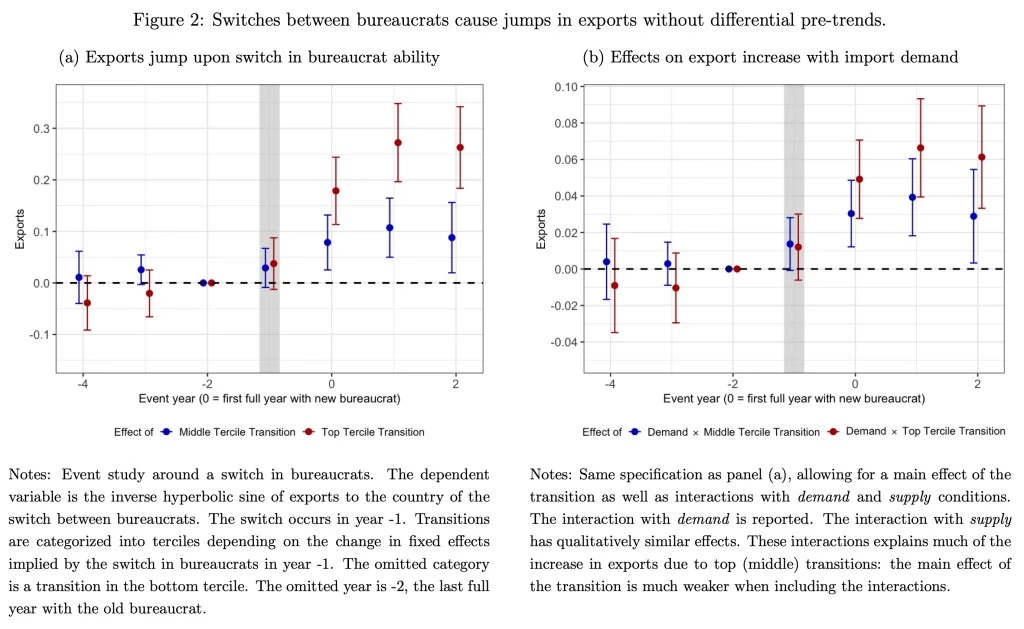This is the 14th in this year’s series of posts by PhD students on the job market
Interest in industrial policy is resurgent among both policy makers and academics. An important argument in favor of industrial policy is based on East Asia’s development success stories. Proponents argue that industrial policy enabled its rapid growth, especially in the case of South Korea. But industrial policies are complex. Perhaps only countries with high bureaucratic capacity can successfully implement them. Understanding to what extent the effect of industrial policy depends on bureaucratic capacity is crucial in determining what lessons low- and middle-income countries can draw from development success stories such as South Korea.
In my Job Market Paper, we provide evidence that the effect of an industrial policy on economic development crucially depends on bureaucratic capacity. South Korea’s overseas export promotion provides an ideal laboratory to study how implementation capacity changes the effect of an industrial policy. Concretely, we find that individual bureaucrats – the directors of country offices – have large effects on exports to their country of appointment.
South Korea’s export miracle and overseas export promotion
South Korea’s economic growth over the last six decades has been unparalleled. In 1960, its per capita income was below that of most African countries. In 2023, it is on par with France. During that period, exports grew particularly fast: From less than 1% of U.S. exports per capita to parity with the U.S. by the 1990s. At the same time, promoting the export sector was a key industrial policy of successive Korean governments. It was also the most positive type of government intervention, as perceived by a representative sample of Korean manufacturers in 1976. Moreover, several characteristics of overseas export promotion make it exceptionally well-suited to study the effect of bureaucratic capacity.
Investigating whether implementing capacity changes the effect of industrial policy has been difficult because doing so requires a setting that satisfies the following conditions: First, we need variation in bureaucratic capacity while holding fixed the policy. This condition may be satisfied if a national policy is implemented decentrally across locations. Second, capacity needs to vary while holding fixed the location, whose economic conditions may directly impact the policy’s effect. Such variation may occur when the bureaucrats move between locations while continuing to implement the same policy. Third, enough bureaucrats need to move so that locations and bureaucrats form large connected sets, ideally one connected set containing all locations and bureaucrats. Fourth, the mapping from bureaucrats to the policy’s effect is one-to-one if there is no multi-tasking: So we need each bureaucrat to work exclusively on one policy whose outcome is measurable in each location – ideally, this outcome needs to be closely linked to economic growth.
We pick a context that satisfies these conditions, in addition to being of substantial intrinsic interest: South Korean overseas export promotion. First, this policy was implemented decentrally in 87 destination countries. Figure 1 displays the countries that have a KOTRA office opening between 1962 and 2001. Most remain operational continuously afterwards. Second, bureaucrats rotate between countries every three years, giving us potentially exogenous variation in the implementing capacity while holding fixed the location. Third, the largest connected set includes 86 of 87 countries. This is due to the frequent movement of bureaucrats and our long period of study (1965-2001). Fourth, in each country the policy has a sole target: exports to that country, an outcome central to economic growth and development. How do these overseas offices promote Korean exports? Mainly, they write reports about market demand, help Korean firms find new trade partners, and organize a Korean pavilion at international trade fairs.
Korean exports increase upon opening an overseas export promotion office
To motivate our study of differences between bureaucrats, we first find that the policy had a substantial effect on average. Our main specification uses the offices’ staggered roll-out to estimate the effect of opening an overseas office relative to a never-treated control group. This choice of control group avoids the bias arising in a two-way fixed effects regression due to the combination of dynamic treatment effects with staggered roll-out of the treatment. Recent advances in obtaining difference-in-differences estimates allow us to test robustness using a not-yet-treated control group (Callaway, Sant’Anna, 2021) and to test how sensitive our results are to violations of the parallel trends assumption (Rambachan, Roth, 2023).
Exports increase by 38% in the ten years after an office opening. Focusing on the extensive margin, we find that the number of products with positive exports increases by 5 percentage points. We are able to rule out the two most plausible alternative interpretations for the event-study findings: (1) Countries do not experience an increase in demand after an office opens, measured as imports to the same country (excluding those from Korea). (2) The scope for strategic timing of office openings is limited as pre-determined gravity variables explain the year in which a country’s office opens. Offices opened first in the nearest markets. Holding constant distance, offices first opened in the largest markets. This appears sensible for an organization that aims to increase Korean exports: It is hard to imagine temporary import demand shocks that trump the static differences in export potential between countries – e.g. between the UK and Denmark.
The bureaucrats in charge of country offices have large effects on exports
We show that the effect of this policy depends tremendously on the bureaucrat who implements it in a particular destination country. To do so, we exploit the three-yearly rotation of bureaucrats between offices. The frequent movement of bureaucrats between offices allows for a “movers design” to estimate the bureaucrat and country fixed effects in explaining Korean exports. Our estimated fixed effects are unbiased under the assumption that bureaucrat fixed effects are uncorrelated with underlying trends in the outcome variable. We investigate this assumption below. Importantly, this assumption is not violated if bureaucrat and country effects are correlated – e.g., if better bureaucrats are assigned to larger countries.
We then quantify how much Korean exports change depending on a bureaucrat’s ability. We find that increasing bureaucrat ability by one standard deviation increases exports by 37%. This estimates the variation in the true bureaucrat effects by correcting for the measurement error included in the estimated fixed effects – the limited mobility bias. The difference between bureaucrats is of a very similar magnitude as an opening’s average effect, suggesting that this industrial policy depends heavily on the bureaucrats who implement it. It loses all its effect when implemented by an ineffective bureaucrat.
Figure 2 (a) investigates the validity of the key assumption. It compares the effect of a switch in bureaucrats depending on the change in bureaucrat fixed effects it implies. It shows that top (middle) tercile transitions are not predicted by differential pre-trends compared to a bottom tercile transition. They do, however, imply a jump in exports by 30% (11%) upon the appointment of the new bureaucrat.
We next investigate what explains the increases in exports due to better bureaucrats. We find that the effect of bureaucrats on exports are concentrated in products with increasing import demand. This aligns with one of the main tasks of the overseas offices: conveying information about market conditions. Figure 2 (b) reports the interaction of bureaucrat transition and import demand. Similar to figure 2 (a), there is no differential pre-trends and a jump upon top (middle) tercile transitions. The magnitudes imply that a top (middle) tercile transition increases the reaction of Korean exports to market demand by 28% (15%).
Key take-aways
This paper shows that individual bureaucrats substantially changed the effect of a key industrial policy. With a different set of bureaucrats, the same policy would have had no effect. This highlights that implementing capacity importantly determines industrial policy’s effect, at least for some industrial policies.
The striking heterogeneity in effectiveness underlines that the reason Korean industrial policy was successful is not because of bureaucrats that are uniformly high performing. Instead, it highlights that good and bad potential bureaucrats likely exist everywhere. The effects on exports due to individual bureaucrats show that putting high ability bureaucrats in key positions matters for economic growth.
Philipp Barteska is a PhD student at the LSE.




Join the Conversation